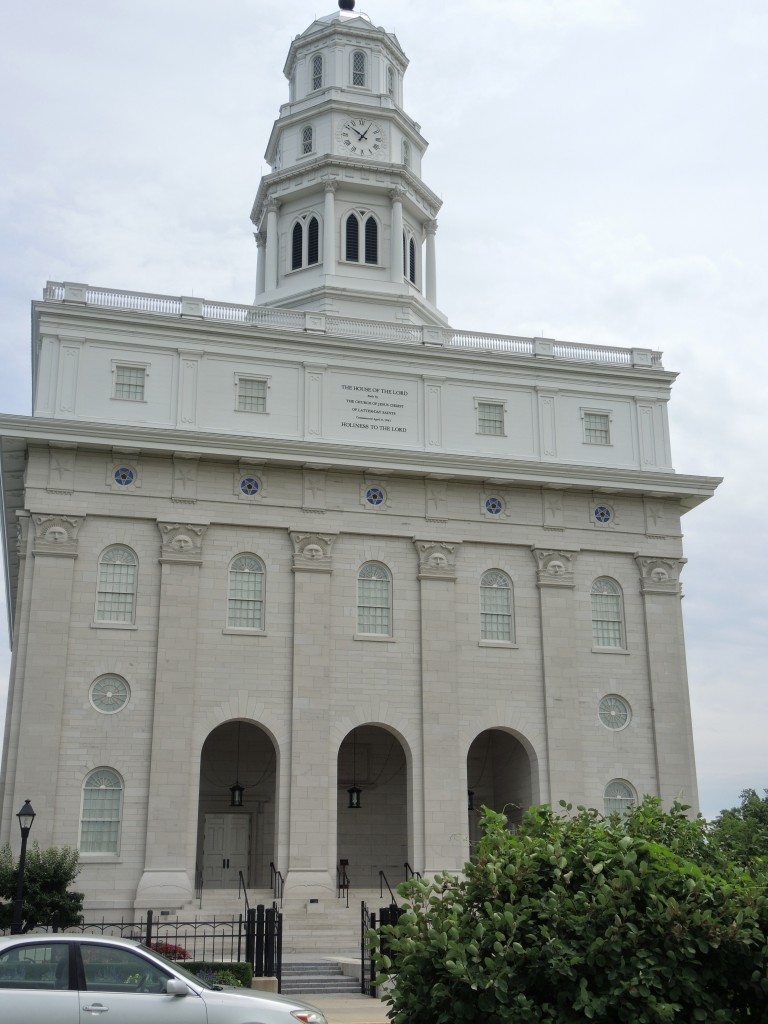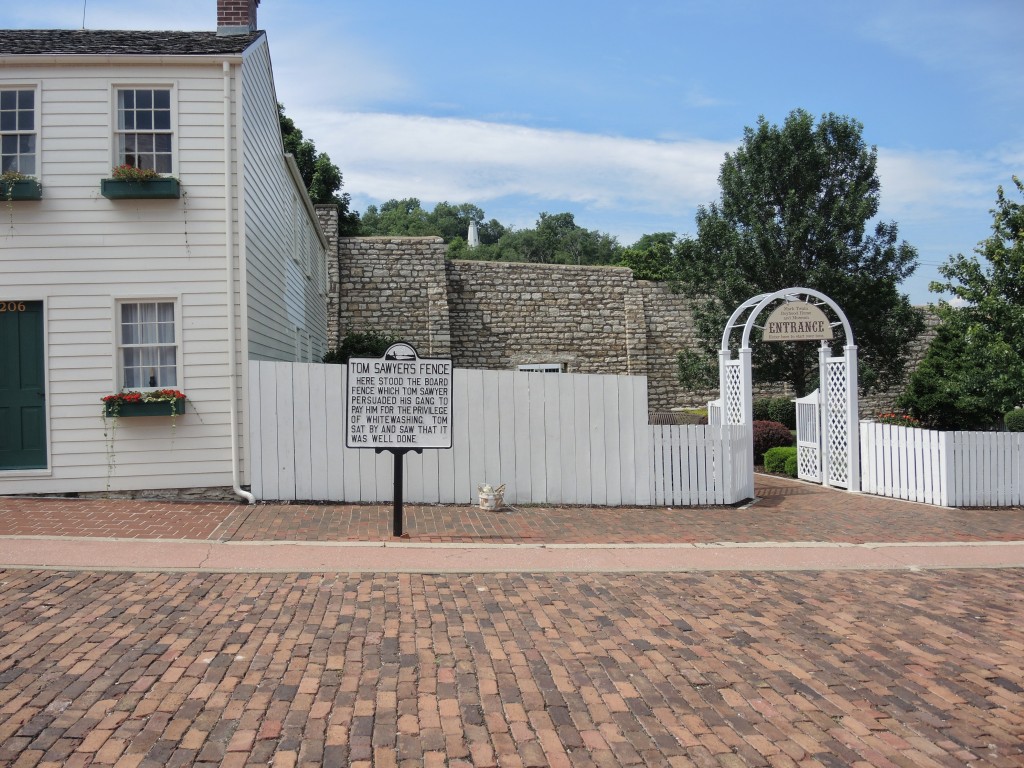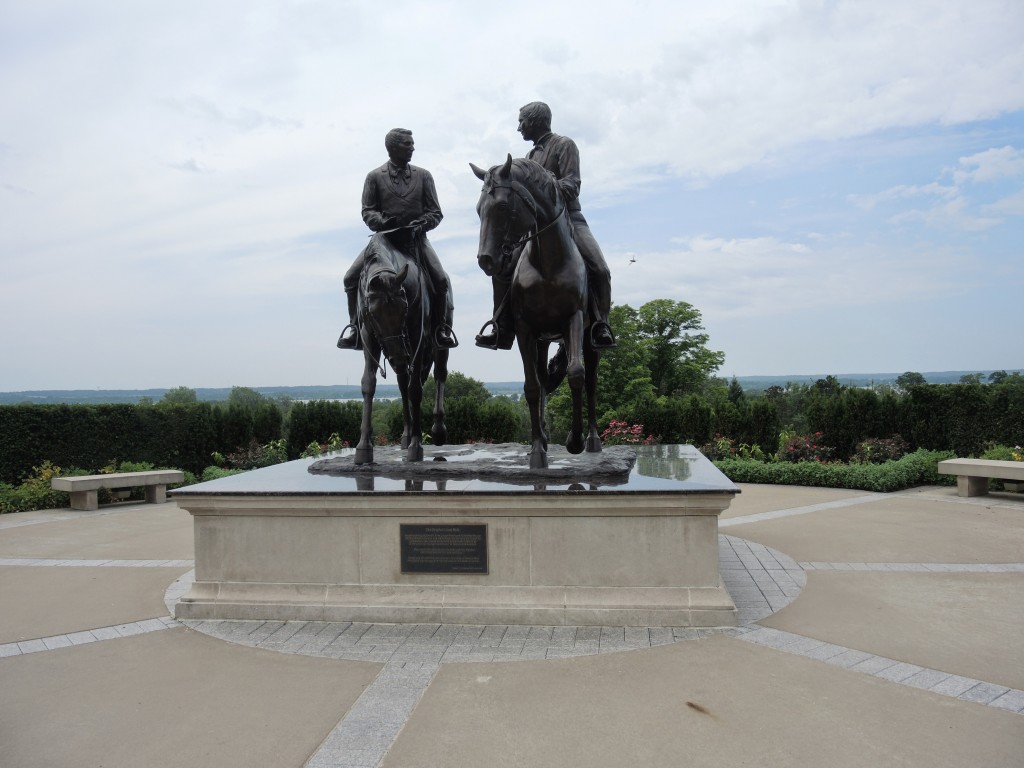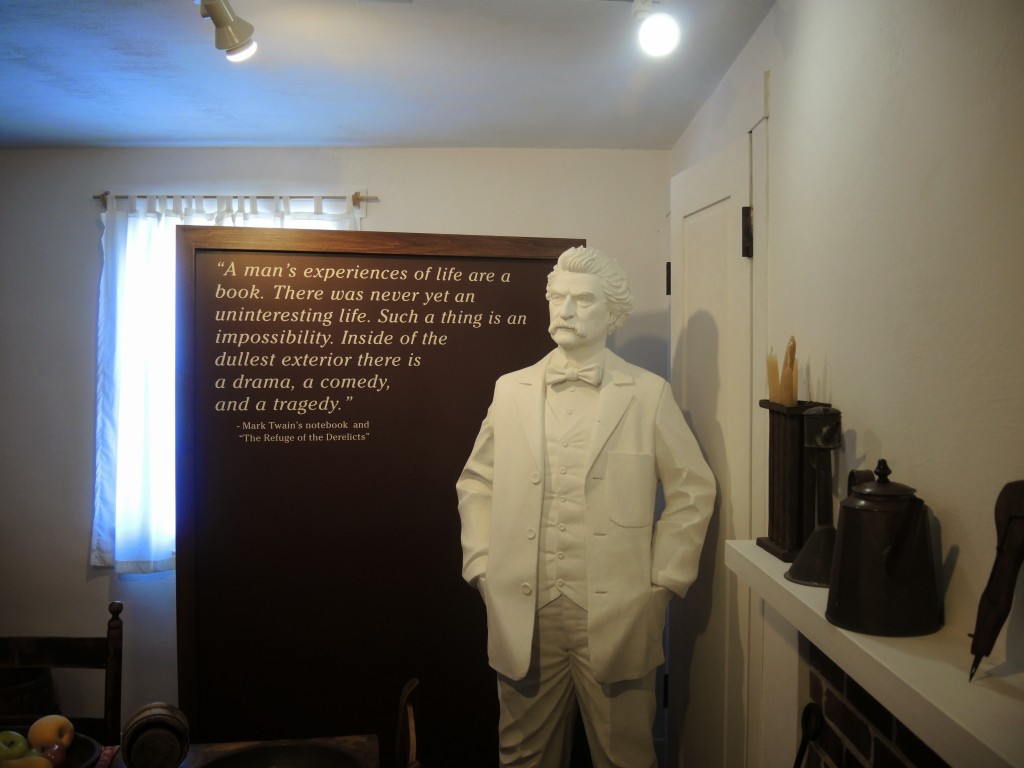Leaving Davenport, I encountered my first real brush with the flooded Mississippi. Though the the river was days past the crest and the water had receded, parts of River Drive were still closed. Davenport is the only one of the five Quad Cities I visited. The Quad Cities are Davenport and Bettendorf in Iowa and Rock Island, Moline and East Moline in Illinois and I will welcome an explanation from anyone who knows why there are five Quad Cities or why they aren’t called the Quint Cities.
On today’s itinerary I had only one planned stop between Davenport and the day’s endpoint – Hannibal, Missouri. That stop was Nauvoo, Illinois. Why Nauvoo? I can only answer that with another question: “What would you get if you crossed an elephant with a rhinocerous?” “Elephino.”
Seriously, Nauvoo is a place of some historical interest and importance. The settlers of interest (in this instance) arrived in 1839 when a group of Mormons – fleeing persecution in Missouri and led by Joseph Smith – purchased what was then the town of Commerce. Within five years, Nauvoo’s population of 12,000 rivaled Chicago as the largest city in Illinois.
For those of you unfamiliar with Joseph Smith, he claimed to have been led by an angel to a book of two golden plates. He published his translation of these plates that became known as the “Book of Mormon” in 1830 after which the angel Moroni took back the plates. By 1831 Smith and his followers – one of whom was Brigham Young – constituted a burgeoning new religion called the Church of Jesus Christ of the Latter-Day Saints. We refer to them colloquially as Mormons. He led his followers west from New York to build an “American Zion” initially settling in or near Independence, Missouri where they practiced polygamy and a form of communalism.
Mormons were frequently viewed suspiciously by non-Mormons in the communities they settled, were often ostracized, and frequently attacked. These actions combined to eventually force them from Missouri where they re-crossed the Mississippi, purchased the town of Commerce and renamed it Nauvoo. Throughout all this, some of Smith’s actions and decisions also aroused great animosity both within and without the Church. William Law and Robert Foster, two of Smith’s one-time followers, had indictments issued against him for polygamy and perjury.
In time, Smith and his brother Hyrum surrendered themselves to the Illinois authorities. Three days after leaving Nauvoo for Carthage, a mob stormed the jail and both were killed. Despite Smith’s death, violence against the Mormons continued until Brigham Young led most of them west to Utah.
There’s much more to learn about Mormon history in Nauvoo and much of the town is geared to teaching it. After an LDS congregation was reestablished in 1956, J LeRoy Kimball, descended from one of the original settlers, oversaw the town’s restoration and its creation as an attraction over a quarter century beginning in the early 1960s. The temple was built (or rebuilt) in 2002 on the site of the original Nauvoo temple. The statue “The Prophet’s Last Ride” was unveiled in December 2003.
After an LDS congregation was reestablished in 1956, J LeRoy Kimball, descended from one of the original settlers, oversaw the town’s restoration and its creation as an attraction over a quarter century beginning in the early 1960s. The temple was built (or rebuilt) in 2002 on the site of the original Nauvoo temple. The statue “The Prophet’s Last Ride” was unveiled in December 2003.
While I was taking a photo of this statue in Nauvoo, which is just outside the Temple, a woman traveling with her daughter and another woman noticed the cap I’d bought at the Field of Dreams. She asked if I’d been there and it triggered a somewhat lengthy discussion of the site and the movie. (This is the first of four FOD cap related incidents – each better than the one that preceded it.)
The Twain shall meet.
From Nauvoo, I continued the journey south and west to Hannibal, Missouri famous as the hometown of one Mark Twain. (Mark twain, by the way, was a term used by Mississippi riverboat pilots to indicate a navigable depth of two fathoms or about 12 feet.) Immediately upon arriving, I checked into my B & B – the Dubach Inn where I met my hosts, Kristine and Steve. Within about 23 seconds I learned that Kristine is the more talkative and social of the two. It turns out that Steve is a baseball fan and his favorite player is Brooks Robinson. Having grown up watching the Hall of Fame third baseman and having met him on several occasions, I thought this might give us something to talk about. But it turned out to be not so much. Still, Steve was kind enough to walk me off in the direction of the Mark Twain Boyhood Home and Museum – my main reason for coming to Hannibal.
I went into some details about Joseph Smith and Mormon history to contextualize my stop in Nauvoo because I assume most readers aren’t familiar with those subjects. I won’t take the same approach when writing about Samuel Clemens, aka Mark Twain. Instead, I’ll simply leap to the conclusion that you have at least some general knowledge of the great American humorist and writer.
My first impression of Hannibal is that it’s a sleepy little town. The population is around 18,000 but the streets were more or less deserted – something I found a bit surprising for a Monday afternoon. As I noted, the Dubach Inn was within walking distance of the Twain Museums but, as has been the case in most of my stops, driving and parking would have presented no issue at all.
My second observation about Hannibal is that it’s all Mark Twain all the time. I refer here not only to the museums and their attendant buildings that attempt to bring fiction to life (Becky Thatcher’s house, the fence that Tom Sawyer painted, etc.) but also to the statue of Tom and Huck Finn, the Mark Twain Dinette, the Mark Twain Hotel, and even the newly opened Mark Twain Brew Pub where I would eat dinner. But then again, I doubt I would have stopped in Hannibal had its only attraction been that it was the home of the Unsinkable Molly Brown.
You can start your Twain experience by looking at Becky Thatcher’s house, Twain’s father’s office, and that whitewashed fence  that also marks the entrance to the interpretive center where you take the tour that might end with Twain’s boyhood home. In the interpretive center, you begin your self-guided tour with a somewhat detailed chronology of the Clemens family’s history and young Samuel’s boyhood. Rounding the first corner, you can watch excerpts from Ken Burns’ three-and-a-half-hour biography.
that also marks the entrance to the interpretive center where you take the tour that might end with Twain’s boyhood home. In the interpretive center, you begin your self-guided tour with a somewhat detailed chronology of the Clemens family’s history and young Samuel’s boyhood. Rounding the first corner, you can watch excerpts from Ken Burns’ three-and-a-half-hour biography.
When you finish here, you go to a reconstruction of Tom Blankenship’s house. Blankenship was Twain’s model for Huck Finn. From there you enter Twain’s boyhood home. I found the display there curious because each room had a sculpted likeness of Twain as a grown man. Now, though Twain did return to Hannibal upon occasion as an adult, there’s no evidence that he stayed or wrote in this house.
For the second time this day, my hat became a conversation starter. A woman approached me and asked if I’d been to the field. As happened in Nauvoo, we talked about her love of the movie and I recounted some of my impressions from my visit. She was with her two sons, one of whom grew quite excited at the prospect of visiting the field.
Your admission to the Twain boyhood home also includes the Mark Twain Museum two blocks down Main Street. (This is why I noted that you might end your tour at Twain’s boyhood home. Admission to the museum is included so you might choose to include it.) On my way, I again bumped into the FoD woman who patiently listened as the older of the two boys tried to convince her to make the trip to Iowa. This museum has more Twain memorabilia, displays about some of his novels, and several original Norman Rockwell paintings depicting scenes from Tom Sawyer and Huck Finn.
For dinner, I went to the newly opened but still under construction Mark Twain Brewery. I could have gone to the Mark Twain Dinette but I didn’t have a lot of other choices since many of the restaurants in Hannibal close on Monday and Tuesday nights. I had catfish and the pub’s American Pale Ale. Neither was particularly memorable.
Hannibal does have a baseball team – the Cavemen. (Readers of Tom Sawyer will recall the important role of the cave where Huck and Tom discover treasure. There is also a Mark Twain cave complex just outside of town that I chose not to visit.) At breakfast Tuesday morning I would learn from Steve that the Cavemen aren’t a true minor league team. None of the teams in this league are affiliated with any major league clubs. Thus, it’s closer to the Cape Cod League in which college players can hone their skills and compete over the summer. Of course, the Hannibal squad plays at Clemens Field which had been closed earlier in the month because of the flood but had just reopened.
Following a stop or two en route, tomorrow takes me to Saint Louis. I’m eagerly anticipating visiting with my friends Kathryn and Paul and taking my second rest day.


Nauvoo… thought that was a character from Star Wars.,no?
I loved the ” Mark Twain all the time” reference. And, I suspect a lot of people aren’t familiar with the more radical side of Mr. Clemons. I am fond of many of his quotes. Especially (paraphrasing) the one where he tells his editor in apology, that his article would have been shorter if he had more time.
Enjoy the Mississippi,
C
I once worked with a Mormon who was a really decent guy. So I asked him about the genesis of polygamy within the LDS. He told me that in the church’s early days they encountered a fair amount of violence, which in turn reduced the number of males in the population. Hence polygamy was adopted to perpetuate the group. Not sure I buy that but it’s a good urban (or in this case rural) legend.
I, too, would have given the go-by to “The Unthinkable Molly Brown.” Loving it!
Excellently punned! So happy to hear from you!